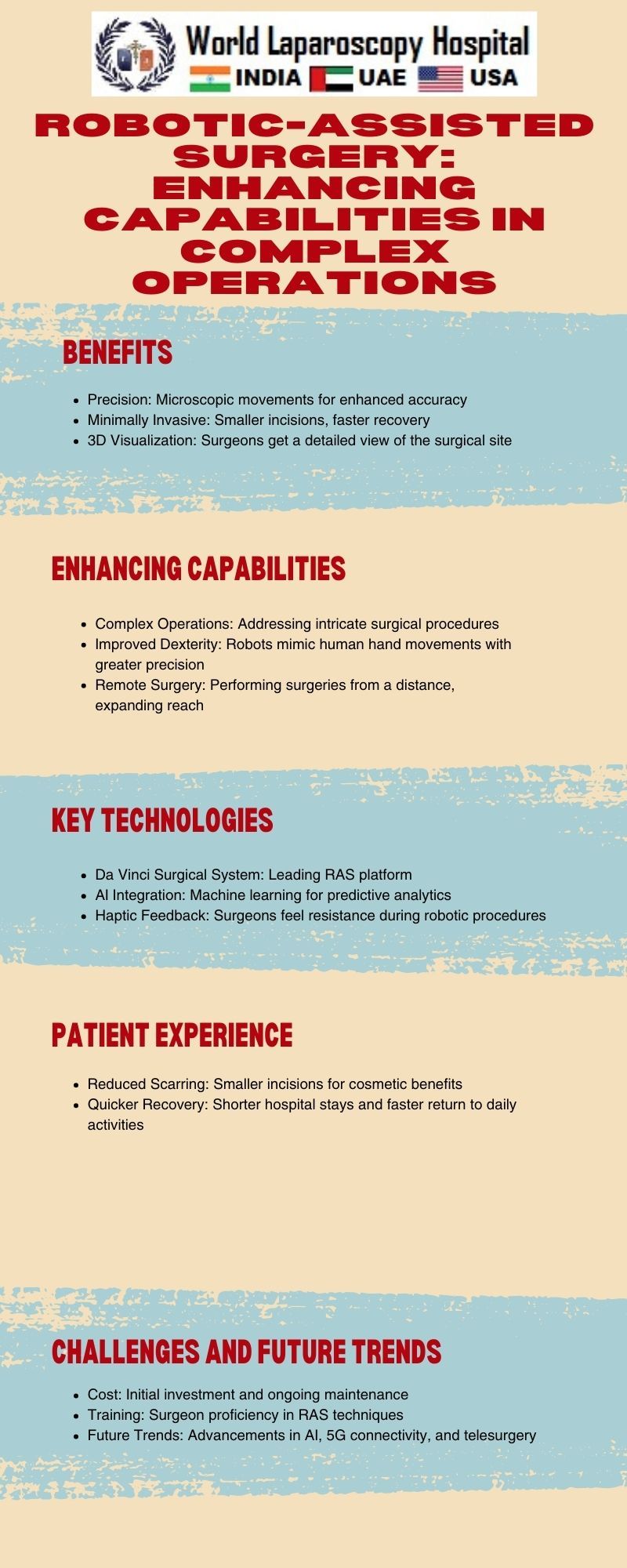Robotic-Assisted Surgery: Enhancing Capabilities in Complex Operations
Introduction:
Robotic-assisted surgery has emerged as a transformative force in the field of medicine, revolutionizing the way complex operations are conducted. This groundbreaking technology combines the precision of robotics with the expertise of skilled surgeons, enhancing capabilities and ushering in a new era of medical innovation. In this comprehensive exploration, we delve into the intricacies of robotic-assisted surgery, its applications, benefits, and the potential it holds for the future of healthcare.

Historical Perspective:
To understand the significance of robotic-assisted surgery, it's essential to trace its historical roots. The concept of using machines to aid in medical procedures dates back to the early 20th century. However, it wasn't until the late 20th century that technological advancements paved the way for the development of sophisticated robotic systems for surgical applications.
The da Vinci Surgical System, introduced in the early 2000s, marked a turning point. This robotic platform, with its advanced robotic arms and high-definition imaging, allowed surgeons to perform minimally invasive surgeries with greater precision. The success of the da Vinci system laid the foundation for further innovations in robotic-assisted surgery.
How Robotic-Assisted Surgery Works:
At the core of robotic-assisted surgery is the integration of robotics into the operating room. The robotic system typically consists of a console where the surgeon sits, a patient-side cart with robotic arms, and a high-definition 3D vision system. These components work seamlessly to provide the surgeon with enhanced control and visibility during the procedure.
Surgeons manipulate the robotic arms from the console, translating their hand movements into precise actions by the robotic instruments. The 3D vision system offers a magnified and detailed view of the surgical site, allowing for greater accuracy in delicate maneuvers. This synergy between human skill and robotic precision is what sets robotic-assisted surgery apart from traditional methods.
Applications in Complex Operations:
Robotic-assisted surgery has found its niche in a wide range of complex operations across various medical specialties. Here are some notable applications:
-
Cardiac Surgery:
- In intricate cardiac procedures such as coronary artery bypass grafting (CABG) and mitral valve repair, robotic-assisted surgery enables surgeons to navigate the delicate structures of the heart with unparalleled precision.
-
Urological Procedures:
- Prostatectomies and kidney surgeries have benefited from the use of robotic-assisted systems, minimizing trauma to surrounding tissues and reducing recovery times for patients.
-
Gynecological Surgeries:
- Complex hysterectomies and myomectomies can be performed with greater precision, leading to reduced blood loss and faster recovery for patients.
-
Colorectal Surgery:
- Robotic-assisted systems have been employed in colorectal surgeries, providing surgeons with enhanced dexterity for procedures such as colon resections and rectal cancer surgeries.
-
Orthopedic Interventions:
- In orthopedics, particularly joint replacement surgeries, robotic-assisted systems aid in achieving optimal implant placement and alignment.
Advantages of Robotic-Assisted Surgery:
The adoption of robotic-assisted surgery has been driven by the numerous advantages it offers over traditional surgical methods:
-
Precision and Dexterity:
- The robotic arms can maneuver with a level of precision that surpasses human hands, allowing surgeons to perform intricate tasks with enhanced dexterity.
-
Minimally Invasive:
- Robotic-assisted surgery is minimally invasive, involving smaller incisions compared to traditional open surgery. This results in reduced blood loss, lower risk of infection, and faster recovery for patients.
-
Enhanced Visualization:
- The 3D vision system provides surgeons with a magnified, high-resolution view of the surgical site, enhancing visibility and facilitating more accurate procedures.
-
Reduced Fatigue:
- The ergonomic design of robotic consoles reduces surgeon fatigue, enabling longer and more complex procedures without compromising precision.
-
Quicker Recovery:
- Patients undergoing robotic-assisted surgery often experience shorter hospital stays and faster recovery times, contributing to improved postoperative outcomes.
Challenges and Considerations:
While robotic-assisted surgery offers numerous advantages, it is not without its challenges and considerations:
-
Cost:
- The initial investment and maintenance costs associated with robotic systems can be substantial, potentially limiting access for some healthcare institutions.
-
Training:
- Surgeons need specialized training to operate robotic systems effectively. The learning curve can be steep, and ongoing training is essential to maintain proficiency.
-
Limited Haptic Feedback:
- The lack of tactile feedback, known as haptic feedback, is a limitation of robotic-assisted systems. Surgeons rely heavily on visual cues, and the absence of tactile sensation can be a drawback in certain procedures.
-
Ethical and Legal Implications:
- The integration of robotics in surgery raises ethical questions, including issues related to patient consent, liability in case of malfunctions, and the potential for over-reliance on technology.
VI. Future Directions:
The field of robotic-assisted surgery continues to evolve, with ongoing research and development pushing the boundaries of what is possible. Some potential future directions include:
-
Artificial Intelligence Integration:
- The incorporation of artificial intelligence (AI) could enhance surgical decision-making and allow robotic systems to adapt in real-time based on patient-specific factors.
-
Telepresence Surgery:
- Advancements in communication technology may pave the way for telepresence surgery, where surgeons can perform procedures remotely using robotic systems.
-
Miniaturization of Robots:
- Smaller, more agile robotic systems could enable surgeries in confined spaces or procedures requiring intricate movements.
-
Global Accessibility:
- Efforts to reduce the cost of robotic systems and enhance training programs could improve global accessibility, ensuring that the benefits of this technology reach a broader population.
Conclusion:
Robotic-assisted surgery stands at the forefront of medical innovation, reshaping the landscape of complex surgical procedures. The synergy between human expertise and robotic precision has resulted in improved outcomes, reduced recovery times, and enhanced patient satisfaction. As technology continues to advance, the future holds even greater promise for the integration of robotics in surgery, ushering in a new era of healthcare excellence.





